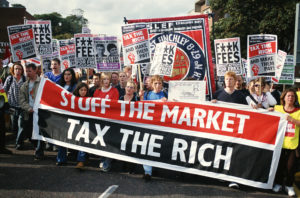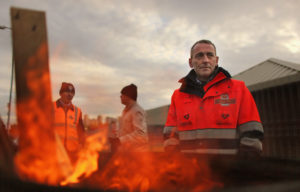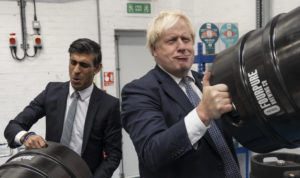“Kevs”, “Neds”, “townies” and “dobbers”. Do these labels mean anything to you? How about “pikeys”, “grungers”, “moshers” and “skate-punks”? If bells are starting to ring, then I’d wager my strongest Pokémon card that you went to a UK secondary school in the Noughties.
The slang-words describe two teenage tribes. One wore Reebok Classics, brands like Ellesse or Diadora, and (often Burberry) baseball caps. They smoked straights, drank alcopops (if they could get hold of them), liked football, and listened to the charts. The girls wore large earrings and carried drawstring bags from sports shops. The boys gelled their hair.
The other lot wore Vans and DC skateboarding shoes, baggy jeans, and Billabong hoodies or rucksacks. They smoked roll-ups and cannabis (if they could get hold of it), liked skateboarding or hacky-sack, and listened to rock or reggae. The girls had heavy eye make-up, and sometimes a nose piercing. The boys did not gel their hair. Read Mods and Rockers, but for pubescents growing up at the turn of the century.
This was a culture war played out in miniature, in an era of relative prosperity and peace. But it’s one which I think, as I’ll explain later, helps us understand modern political divides.
At my secondary school in Norwich, the two clans were omnipresent and — to start with, at least — mutually exclusive. I was ushered into the former tribe, when it became clear that I liked football and had never stood on a skateboard in my life. Each UK region had different descriptors for the groups, I later learnt, but our area used “townie” and “pikey”. “Pikey” is an unusual choice, given it’s used elsewhere as an abusive term for travellers, whose dress sense is often closer to “townie” culture. But for whatever reason it became the shorthand for the skaters.
As well as a general mood of sectarianism between the two groups — a “pikey” girl in my class was beaten up by “townies” from another school in Year 8, and retributions followed — there were political differences, too. Those who marched against Iraq were mostly of “pikey” heritage. And “pikeys” saw themselves, more generally, as upholding social liberalism. This largely involved mimicking the other side’s use of the word “gay” (an all-purpose “townie” insult at the time) by grunting “Yer gay” in the broadest Norfolk accent they could muster. This backfired, in progressive terms, as many “pikeys” discovered a liking for the term “gay” once they’d sampled it, and were soon chucking it about just as casually as their “townie” peers.
By age 16, affiliations had weakened. The clans had discovered common ground — or common enemies. People mixed and matched. And every now and then a “pikey” would surprise the “townies” by revealing themselves, under the big shoes and pocketed trousers, to be good at football. In particular, the ubiquitous desire for marijuana, alcohol and cigarettes made it necessary for the identities to mingle. A large group of smokers in our year — of both “townie” and “pikey” vintage — took to loitering in a circle at the end of the field, furtively imbibing cannabis or tobacco, and hocking phlegm into a huge, symbolic puddle of shared mucus.
Yet a duality remained. Many former “townies” left school at 16 or 18, and went to work — sometimes earning decent salaries and getting on the housing ladder, sometimes not. They had more money to spend and went out in different clubs — the sort where local footballers frequented the VIP area. And they learnt to drive.
“Pikeys”, meanwhile, morphed into hippies or indie kids. They did not want to be known as “geeks” any more than the “townies”. But when the moment came, they were more likely to stay on at Sixth Form — and then, often, to leave the city to study or travel. As economic inequality moved into focus post-2008, some will have learnt to see terms such as “townie” and “chav” as marks of bigotry — little better than racial slurs. Many former “pikeys” may now, in fact, be more offended by these words than those they once used them against.
The phenomenon I describe — evident across many parts of Britain, and especially away from big cities — ran far deeper than hobbies and fashion. Its roots were social. Where I grew up, “townies” mostly came from houses built this side of the Second World War. Some lived on the council estates which formed part of the school catchment. Many others lived on newer developments further out, or in expanses of owner-occupied suburban semis. We lived in a city and were proud of this status, but the “townie” strongholds — as their label, I suppose, implies — tended to be the areas which were least urban or least urbane.
The “pikey” spirit, by contrast, emanated from — although was not unique to — the Victorian or Georgian terraced houses closer to the city centre. These had bay windows and smaller gardens, and were en route to the university, in and around an area known as the Golden Triangle. This neighbourhood was characterised by its shabby chic tastes, strong social capital and high house prices. It was not super-rich, by any means, and may not even be much more affluent than “townie” dominated areas further out. But its sense of itself was quite different.
So, what does this nascent identity politics, conducted on the playing fields of Blair’s Britain, tell us about the UK in 2023? It would be daft to overstate it, but I think some contemporary fault-lines are evident.
The first is about what I’d call “the glossy and the matte”. This is a political distinction for all the ages; between those looking to advertise their social status and those looking to disguise it. Dressing up and dressing down, new money and old, gaucheness and “good taste”. Even George Eliot’s Middlemarch, set in the 1830s, touches on the same theme. It’s telling, I think, that my school, comprised as it was of a pretty ordinary economic intake, devised an alternative caste system on the basis of glossy and matte preferences.
Many of the subtler barriers to modern social mobility come down to the same distinctions. Amol Rajan’s documentary “How to break into the elite” depicts working-class graduates donning sharp suits for job interviews in the arts, only to find that the well-paid executives interviewing them are wearing t-shirts and trainers.
The second fault-line is between economic and cultural capital; materialism and post-materialism. It’s a while since I read Chavs by Owen Jones, but one thing that didn’t ring as true when I did was the idea that anti-“chav” sentiment sought to deride poverty. In my experience, at least back then, it was about a mutual contempt, between those who valued the signifiers of wealth or status and those who valued the signifiers of taste or intellect. It’s true that most of those in social housing were “townies”, but it’s also true that most of the “townies” I went to school with did not live in social housing.
I do think that the hierarchy which “pikeys” sought to create was just as bad as that which “townies” were cultivating. But I don’t think it was quite as simple as “haves” mocking “have-nots”. Certainly, this isn’t what “pikeys” thought they were doing. Many regarded themselves as the underdogs, and their primary accusation was that “townies” were parochial — not that they were poor. In return it was they — the “dirty pikeys” — who were disparaged for their lack of respectability.
The most obvious modern echo here is the Corbyn project. Scruffy and proud of it, the movement was contemptuous of what Tony Blair called “aspiration”. Corbyn and his team spoke primarily to post-materialist values and higher cultural capital, and appeared to see those who valued economic capital — “townies” and their ilk — through the lens of “false consciousness”.
Third, the fissure exposed a fault-line between mainstream and alternative. One interesting thing about my school’s dynamic was the fact that “townies” and “pikeys” were so evenly matched in terms of numbers. A generation beforehand, “pikey” culture might have been peripheral, but by the time I went to school there were whole industries dedicated to “pikey” clothing and music. “Pikey” — ism was, at core, an act of rebellion — against suburban conformity and materialism. But, by 2001, striking out in this way was a popular pastime.
This links to a perennial question for those in the “alternative” corner: what happens when the identity you champion becomes mainstream? Many culture war debates relate to this. James Harris recently critiqued Stewart Lee, for example, for continuing to base his comedy on the idea that he’s part of a pioneering Left-wing vanguard. In fact, Harris writes, Lee’s liberal values are now very common.
Finally, as I’ve already touched upon, the “townie”-“pikey” split often ran along the fault-line between those who stay in the town and those who migrate elsewhere. Analysis from a few years ago cast this as a central tension in US politics, determining which way people voted in 2016. And Brexit may well have followed the same pattern.
Why were “townies” more likely to stay in the place they grew up and “pikeys” to move to bigger cities? Beyond some of the socio-economic reasons, and those relating to access and expectations, there was a values dimension. Just as “townie” clothing was about adhering to the rules of contemporary fashion, the “townie” approach to life was commonly about succeeding within the framework of the place you lived. “Pikeys”, by contrast, often styled themselves as misfits, for whom “every day was like Sunday”. They rejected the framework and were less tied to the place itself.
The upshot of this is that many “townies” and “pikeys”, pulling in opposite directions from the very start, may have diverged more and more as the years passed. This applies to the age they had children, their experiences of the UK housing market and whether they cycle or drive.
So, what became of the “townies” and the “pikeys”? They’re now in their mid-30s, and the world has changed shape since they were buying Nokia phone cases, watching Ali G, and half-listening to their parents discuss 9/11. The caps and skateboards have been retired, the gold chains and hacky-sacks decommissioned. But in a sense, I think, the confused conflict which they were engaged in lives on.
It governs how people define “success” in their own lives, and it explains why many of the polarisations which emerged after Brexit were so heavily rooted in symbolism, be it TV or food preferences. For millennials trying to make sense of all this, it’s worth taking a trip down memory lane, to the classrooms of 2000s Britain and the strange social eco-system which existed there.
Disclaimer
Some of the posts we share are controversial and we do not necessarily agree with them in the whole extend. Sometimes we agree with the content or part of it but we do not agree with the narration or language. Nevertheless we find them somehow interesting, valuable and/or informative or we share them, because we strongly believe in freedom of speech, free press and journalism. We strongly encourage you to have a critical approach to all the content, do your own research and analysis to build your own opinion.
We would be glad to have your feedback.
Source: UnHerd Read the original article here: https://unherd.com/




